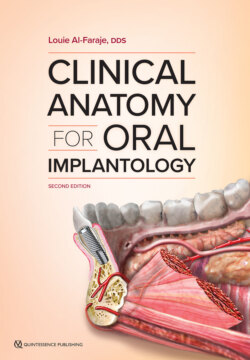Читать книгу Clinical Anatomy for Oral Implantology - Louie Al-Faraje - Страница 19
На сайте Литреса книга снята с продажи.
Mandibular nerve (CN V3)
ОглавлениеThe mandibular nerve (Fig 1-12a) is the third branch of the trigeminal nerve, arising from the trigeminal ganglion. Unlike the other two branches (the maxillary and the ophthalmic nerves, both entirely sensory), the mandibular nerve has both sensory and motor divisions.
FIG 1-12 (a) The mandibular nerve. (b) Region of skin supplied by the mandibular nerve.
After passing through the foramen ovale and branching off into a meningeal branch in the infratemporal fossa, the nerve divides into the sensory branches—the auriculotemporal, lingual, inferior alveolar, and buccal nerves to the skin over the mandible, lower lip, temporal region, and much of the oral cavity (Fig 1-12b)—and the motor branches that innervate the muscles of mastication (masseteric, deep temporal, and pterygoid nerves).
The inferior alveolar nerve carries motor fibers for the mylohyoid muscle and the anterior belly of the digastric muscle and sensory fibers that enter the canal through the mandibular foramen; it gives branches to the mandibular teeth and exits through the mental foramen under the mental nerve (see chapter 7). Damaging the inferior alveolar nerve will alter the sensation to areas supplied by it and by the mental nerve. Branches of the trigeminal nerve are also frequently used to distribute fibers derived from other cranial nerves.
